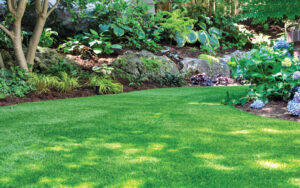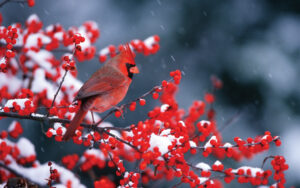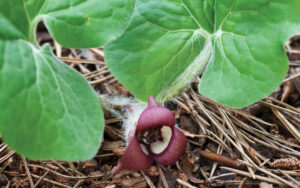Ground cover plants can benefit gardens in terms of soil prevention, moisture retention and weed suppression.
Looking for an environmentally responsible way to add texture and color to your landscape? Ground cover plants just might be the solution.
Ground covers are low-growing plants you can install in addition to, or in place of, a high-maintenance lawn that can be expensive to mow and treat.
Other benefits to ground covers include soil erosion prevention, weed protection, and moisture retention. Last but not least, ground covers are great pollinators for bees, butterflies and birds.
Good ground cover choices for shaded areas include:
Wild ginger (Asarum canadense) flower in early spring in central Virginia.
(SHUTTERSTOCK / GERRY BISHOP)
Wild Ginger (Asarum canadense)
Native to our region, this perennial, slow-spreading ground cover reaches a half-foot in height and has a small brownish purple flower that grows underneath the leaf. Wild ginger appears in early April-October and spreads to an area of five feet in about five years.
Partridge Berry (Mitchella repens)
Native to our region, this perennial, slow-spreading ground cover reaches a half-foot in height and appears in April-November. This plant has white flowers during May and June, and scarlet berries in July and August. Partridge Berry spreads to an area of five feet in five years and is deer-resistant.
Green and Gold (Chrysogonom viginianum)
Native to our region, this perennial plant has moderate growth in sunlight and slower growth in shade. Green and Gold reaches a half to one foot in height and appears in March with yellow flowering during March and April. The plant spreads to an area of three feet in three years, and is fairly deer-resistant.
Alleghany Pachysandra (Pachysandra procumbens)
Native to West Virginia and Eastern Kentucky, this semi-evergreen to evergreen perennial is slow-spreading, reaching one foot in height. The plant produces white, fragrant flowers in March and April, and boasts attractive bluish green foliage. Alleghany Pachysandra spreads to an area of three feet in three years and is deer-resistant.
Wild Stonecrop (Sedum ternatum)
Native to our region, this perennial, slow-spreading plant appears in late March-November. Wild Stonecrop reaches a half-foot in height and has greenish white flowers in April-June. It spreads to an area of one foot in two years and is an excellent plant for rock gardens.
Creeping Phlox (Phlox stolonifera)
Native to our region, this perennial, slow-spreading plant appears in late March-October. Creeping Phlox reaches a half-foot to one-and-a-half feet in height, and produces red-purple and red and blue flowers from April-June. It spreads two feet in one year and is perfect for planting along a garden path.
Good ground cover choices for sunny areas include:
Creeping Thyme (Thymus praecox or T. serphylum)
A non-native plant of West Asian origin, this evergreen plant forms low-density mats no higher than three inches. Creeping Thyme spreads one foot per year, prefers well-drained soil and can be a substitute for grass between stepping stones. This plant should not be used as a culinary herb! Creeping Thyme’s lavender flowers appear in June and are deer-resistant.
Lamb’s Ears (Stachys byzantine syn. Stachys lanata)
A non-native plant of Asia Minor, Lamb’s Ears are semi-evergreen in the Piedmont region. The plant grows to a height of one foot, forms clumps and will grow on slopes. It gets its name from the fuzzy, silver-grey leaves resembling the shape and texture of the ears of a young lamb. Lamb’s Ear provides lots of texture to a landscape, is deer-resistant and can be grown in well-drained soil.
Sweet Woodruff (Asperula odorata syn. Galium odorata)
This non-native plant of Asia Minor is perennial and reaches eight inches. Sweet Woodruff forms clumps of upright stems with green deciduous foliage and star shaped white flowers through April and May. It spreads one foot per year and should be grown in humus, well-drained soil in sun to partial shade.
Invasive ground covers to avoid:
Stay away from Pachysandra (Pachysandra terminalis), English Ivy (Hedera helix), Yellow archangel (Lamiastrum) and Common periwinkle (Vinca minor). These plants are difficult to control and eradicate. They can be aggressive growers and smother other plants, including native varieties.
Rebecca Brown began her career as a horticulturalist more than 25 years ago and studied at the New York Botanical Gardens. She has been a University of Maryland, Baltimore County master gardener for eight years and is a backyard beekeeper.
Norman Cohen is a retired chemist. He has been gardening for 39 years and has been a University of Maryland, Baltimore County master gardener for 13 years. Cohen also provides gardening education to the public at local farmers markets.
You May Also Like Gardening Tips: Made in the Shade 
Creative usage of shade can help your gardens bloom and thrive.
Gardening Tips: Birds, Blooms and Berries 
Loooking to spruce up your yard? Mixed native shrub borders bring beauty and attract birds and pollinators.
Gardening Tips: Passion Planting 
In recent years, gardeners have discovered the many virtues of native plants and trees. Rebecca Brown and Norman Cohen highlight some good options and the key factors to consider.
Gardening Tips: Best Laid Plants 
Beware of squirrels and chipmunks who are mighty fond of the taste of tulips. If you can’t keep critters away from your tulips, try planting daffodils instead. They’re poisonous and hence, critter repellent.
The post Gardening Tips: Taking Cover appeared first on marylanddigest.com.
